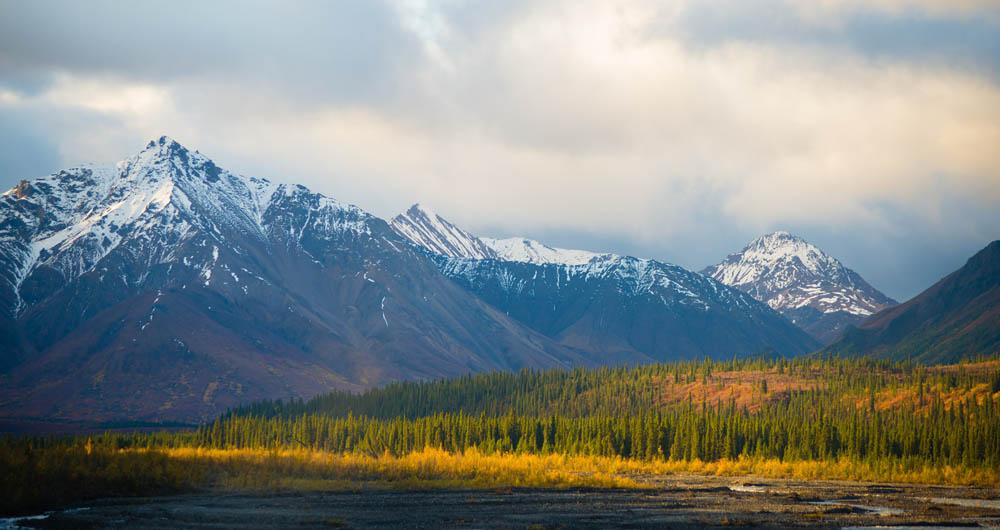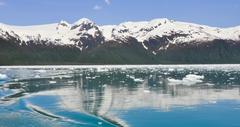Denali National Park, Alaska's first national park, spans across six million acres of wilderness, with only one road that bisects the park. The park was established in 1917 by the United States Congress in order to protect the wildlife living within the Alaska Range. The park's size tripled in 1980 when Congress expanded the park to include the entire massif of "the Mountain" within Denali National Park's boundaries.
Visitors traveling down the Park Road watch as low-elevation taiga forests turn to high elevation alpine tundra and snowy mountains, leading up to Mount Denali, the tallest peak in North America at 20,310 feet. The park wildlife live as they always have, roaming freely throughout the land. Denali National Park, AK, has been a destination for adventuring and mountaineering for over a century. The park still continues to attract climbers, skiers, pack-rafters, athletes, hikers, and dog mushers who desire to test themselves against the truly wild landscape.
Discovery Hikes

Discovery Hikes are an excellent way for well-prepared and adventurous visitors to explore Denali National Park. Guests should expect unpredictable weather, uneven terrain, encounters with heavy vegetation, and small stream crossing during these ranger-led hikes. The Discovery Hikes travel off-trail through the park's wilderness and last from three to five hours. The hikes range from moderate with elevation gain less than 1,000 feet to strenuous with elevation gain greater than 1,000 feet or with large river crossings.
Sled Dog Demonstrations
The park rangers and dogs work together to exhibit a traditional Alaskan mode of transportation. The special 30 minute demonstration includes a chance to tour Denali National Park's kennels and visit with the park's Alaskan huskies. Shuttles leave for the park kennels from the Denali Visitor Center around 40 minutes prior to each demonstration.
There is no parking available at the kennels, so visitors should plan on using the shuttle or walking the 1.5 mile trail from the visitor center. Park guests can also visit the kennels outside of one the demonstrations. The Denali National Park kennels are open year-round, however, many of the dogs are often out on runs during the winter.
Guided Walks and Hikes
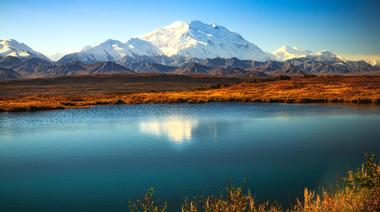
Denali National Park also offers an array of less adventurous walks and hikes led by rangers. A ranger-led walk or hike is a great way for guests to learn more about the park. Park visitors can join a Nature Walk, which travels along one of the trails starting from the Denali Visitor Center. The walks vary and can be up to three miles round trip. The Nature Walks take an easy pace as participants travel through the taiga ecosystem. The slope of the trails range from easy to moderate at various points and the walk takes around two hours. Visitors may spot moose, red squirrels, spruce grouse, and various flower or berries depending on the season.
The Hike to the Park Kennels lasts about 2.5 hours and begins at the Denali Visitor Center. The trail has several uphill sections, but is still easy paced. The elevation gain offers an overlook stop with spectacular views on a clear day of the surrounding mountains. A ranger will lead hike participants through aspen and spruce in search of in-season berries or wildflowers, as well as wildlife.
The Eielson Stroll walk, beginning at the Eielson Visitor Center, is a half mile trail that is visitors can enjoy at a leisurely pace. The 45 minute to an hour ranger-led walk travels through high alpine tundra. The trail offers great views of Denali on clear days, as well as the possible opportunity to sight large mammals, including grizzly bears. Park guests can reach the Eielson Visitor Center via any Eielson, Kantishna, or Wonder Lake shuttle. The Eielson Visitors Center also offers the Eielson Alpine Hike, a strenuous, 2 to 2.5 hour ranger-led hike up and down the Thorofare Ridge. The Eielson Alpine Hike also offers views of Denali in the high alpine tundra and the chance to see wildlife.
Hiking
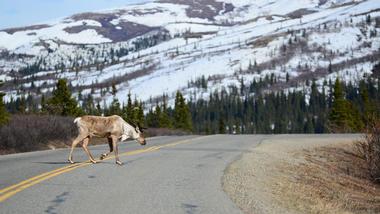
Visitors to Denali National Park and Preserve can explore the land on either marked trails or off-trail in almost any direction. The park doesn't contain many trails, and most of the marked trails are short enough to the point that you could travel along several on one day. The reason for such a small amount of trails is that the park exists in order to provide visitors a chance to explore the wilderness. The majority of marked trails are located around the Denali Visitor Center. Some of the trails follow alongside the Park Road and connect the visitor center to other park facilities, such as the kennels and Riley Creek Campground, near the park entrance. Other trails travel into the immediate surroundings of the Park Road, offering visitors a chance to find some solace while still having a marked path to follow. Most trails are considered easy to moderate in difficulty. There are also a few trails that are found further into the park, beyond the Denali Visitor Center.
The Savage River Loop can be found in the Savage River Area, located at Miles 13-15 on the Park Road. This 2 mile long, easy walk travels along the river. The trail surface can be uneven and rugged in some spots, but there is not much change in elevation. Visitors can reach this trail by car or via a shuttle from the park entrance. The Savage Alpine Trail, stretching more than four miles, is a more strenuous hike, and connects the Savage River Campground to the Savage River area.
Located at Mile 66 on the Park Road, the Eielson Visitor Center area offers spectacular views of Denali on clear days. Visitors can reach the visitor center by shuttles traveling to Eielson and beyond. The Tundra Loop is located near the visitor center in alpine country and is only one third of a mile long. There is also an additional one fourth of a mile, one-way trail that branches off of the Tundra Loop. The more difficult Eielson Alpine Trail is a steep hike at 1,000 feet up Thorofare Ridge. The trail is less than one mile, and provides amazing views on a clear day.
The Wonder Lake area, found at Mile 85 along the Park Road, contains the McKinley Bar Trail. The 2.5 mile long, one-way trail is the only one in the area. It travels past several small ponds, providing a chance to see waterfowl and through spruce forests. Hiking off-trail excited some visitors, but worries and confuses others. The Denali Park Road and the park's bus system, as well as the terrain itself, make hiking off-trail more approachable to nervous visitors.
Wildlife Viewing
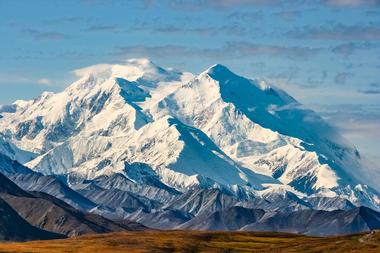
Denali National Park and Preserve contains 169 bird species, 39 species of mammals, 14 fish species, 1 species of amphibian, and no reptiles. Lucky visitors may spot some of the park's most iconic large mammals, such as moose, caribou, grizzly bears, black bears, Dall's sheep, and wolves. Smaller mammals, such as arctic ground squirrels, red squirrels, marmots, and foxes, are seen more often. The park's bird life is diverse and remarkable. Among the largest birds in Denali are the rare Bald Eagle and the Golden Eagle. The more commonly seen bird life in the park includes gray jays, ravens, ptarmigan, and mew gulls.
The best opportunity for visitors to view wildlife is most likely on a bus ride along Denali's Park Road. There's a chance of spotting wildlife while hiking, however, those sightings are less likely. While hiking in Denali National Park, visibility is often reduced greatly in or near brush. The park's wildlife are accustomed to the noise of the busses that travel down the road, but not as much to the noise of visitors hiking throughout the grounds. The animals might easily get spooked. Guests hiking in the park should acquaint themselves with appropriate and safe behavior before arriving in case they encounter a wild animal. While hiking along a river offers more visibility, that chance of encountering a bear or moose is greater. The high alpine areas offer more visibility and allow visitors to better avoid large animals they may encounter before they get too close.
Wildlife in Denali are more often seen at a distance, so visitors are encouraged to bring binoculars and stronger cameras. Sometimes wildlife will come near, or even on, the Park Road. Bus drivers will usually stop if animals are spotted. Animals that travel in herds, such as sheep and caribou, are often seen only in small numbers and from a far distance.
Park Kennels
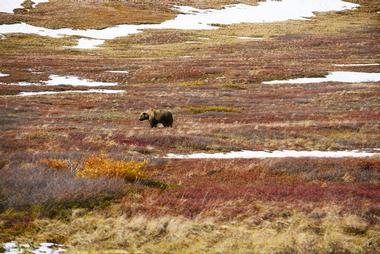
Denali National Park and Preserve's sled dogs have been played a significant role in the park for so long that they have now become part of the park's resources, and are a cultural tradition worthy of protection. The dogs, as well as they kennels in which they live, represent meaningful parts of the American story.
They are culturally significant, symbolizing the Native Alaskan and pioneer experience in the far north. The dogs also play a part in the history of the park. Denali's sled dogs are the only ones in the country that assist in protecting a national park, as well as the scenery, wildlife, and wilderness within the park. These dogs have been protecting Denali National Park for almost as long as the park has existed.
Backpacking
There are no backcountry campsites, trails, or designated routes in Denali National Park's backcountry, making the park unique in comparison to other national parks. The idea is to provide visitors with the means of self-reliance and give them a chance to discover the park on their own. Park rangers provide guests with information to make their backpacking trip as safe and enjoyable as possible. A permit is required for camping in the backcountry.
George Parks Hwy, Denali National Park and Preserve, Alaska 99755, Phone: 907-683-9532


